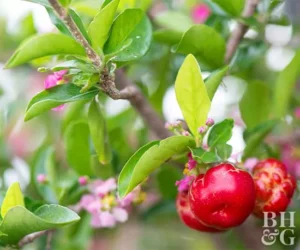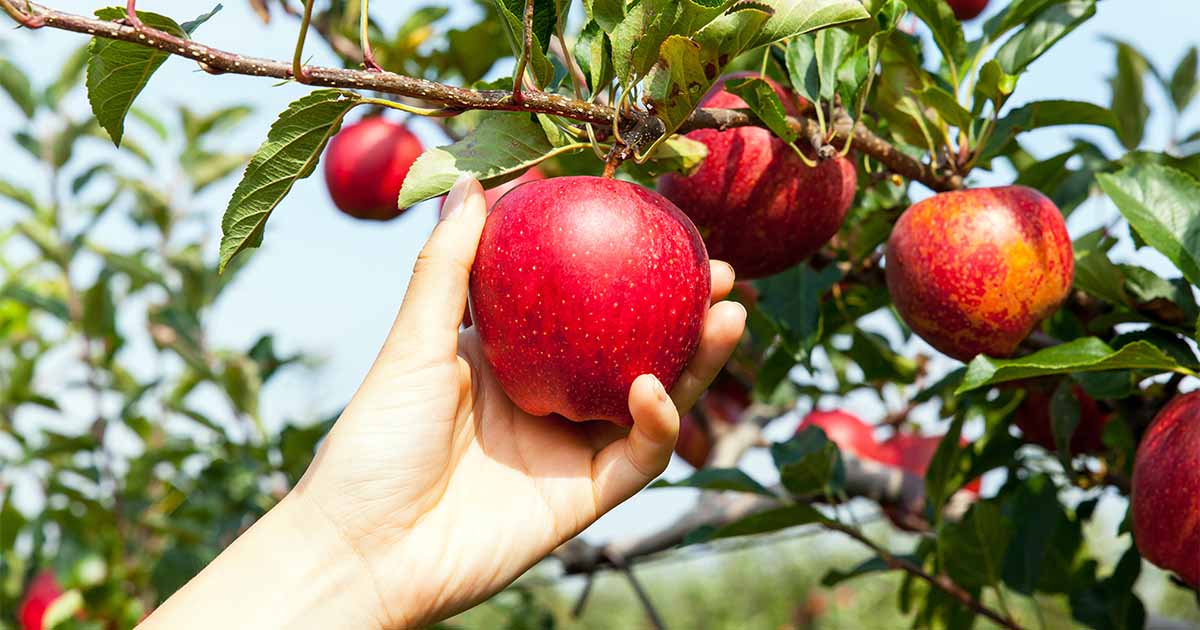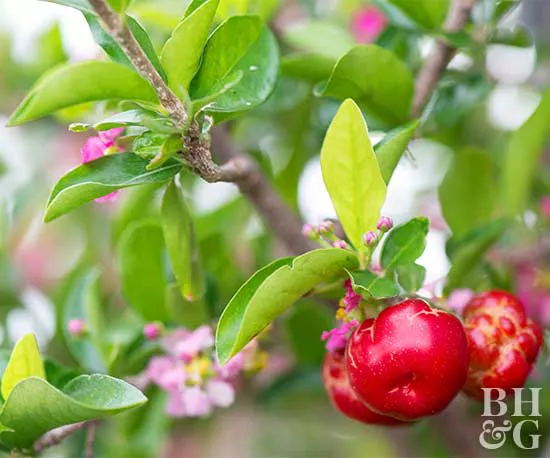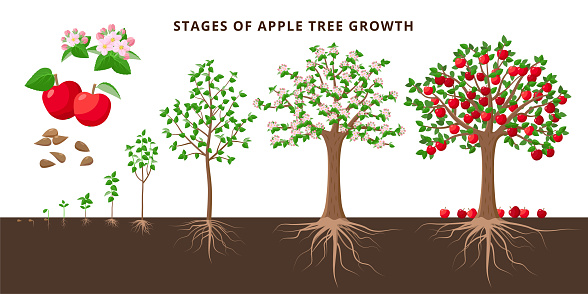The key to successfully growing apples is to pick the right spot. All apples do best in full sun and moist, well-drained soil. Although the trees thrive in a wide variety of soils, avoid planting them in low or wet spots—they don’t grow well in situations where there’s standing water for extended periods.
:max_bytes(150000):strip_icc():gifv():format(webp)/102667784-759b932d4c7b4dbc99081d6ccb89b648.jpg)
You can plant apples anytime from spring to fall. As is the case with most trees and shrubs, dig a hole that’s twice as wide as (but no deeper than) the pot your apple tree comes in. Carefully remove the tree from the pot, loosen its root ball, and spread the roots so they face outward. Fill the hole with the soil you dug out (don’t fill the hole with amended soil), and then water the tree well.
How to Select Apple Trees
There are more than 7,000 varieties of apple—because each is different, take the time to research the best selections for your area. The staff at your local cooperative extension service or local garden center or nursery should be able to help you choose.

Test Garden Tip: Apples bear best when there are two varieties nearby to pollinate each other. In fact, some apples have to be pollinated by another variety in order to bear fruit—so be sure to take note of special needs such as this when you select varieties for your yard.
Growing Apples in Containers
If you have large containers (at least 4-5 feet in diameter), you can grow apples in pots. Choose dwarf varieties, which won’t become too large for the containers. Fill the pots with a high-quality potting mix. It’s best not to use garden soil as it doesn’t drain well in containers.
In Zone 6 and warmer, you can leave the pots outdoors all year. But in colder climates, it’s best to move the trees to a more protected spot, such as an unheated garage or storage shed for the winter.

It’s important to keep container-grown apple trees watered well. You’ll also want to fertilize your apples with a general-purpose timed-release plant food each spring to ensure the tree has enough nutrients to bear a healthy crop of apples.
Training and Pruning Apples
Like many trees, apples have a central leader—a main, upright trunk—that the branches grow out from. If your tree starts to develop a second, competing central leader, remove the competing branch. This helps keep your tree stable and healthy.
Also, cut out any branches that grow toward the inside of the tree. Your apple tree will stay healthiest if you prune it so it has something of an open framework, meaning the main branches are spaced well apart so sunlight and air reach all the way through the tree’s canopy.

When to Prune: The best time to prune your apple is in late winter or early spring, while the tree is dormant. Always remove any branches that have died, as well as shoots that pop up around the tree’s roots and the fast-growing shoots called water sprouts that grow vertically out of the branches.
It’s beneficial to remove the flowers of developing fruit the year you plant an apple tree (or the following year if you plant it in the fall). This helps the tree become established faster.
Espalier: You can also train apples to grow flat along a wall or fence. This decorative process, known as espalier, also makes harvesting easier.
There are early-, mid-, and late-maturing apple varieties, so the harvest season can stretch from August to October.
Pick apples from the tree when they separate easily from the branch and have firm flesh. Soft apples are overripe but can be used for cooking. Store them in a cool spot (under 40 degrees F) after harvest.
Can You Grow Apple Trees from Seed?
A common question is whether it’s possible to simply plant the seed of a variety that you like rather than buy a young tree. While it’s certainly possible to grow an apple tree from a seed, the apple tree you get probably won’t be the kind you hoped for!

Apple seeds are genetically different from their parent tree, which means that things like tree size, hardiness, and fruit quality will differ (and will usually be poorer). So, if you plant a Honeycrisp seed, you won’t end up with Honeycrisp apples. Plus, it can take 8-10 years for an apple seedling to grow big enough to produce apples, so you may end up waiting awhile!
Apple Trees Need Friends
Most apples need pollen from another apple tree to produce fruit. This is called cross-pollination. This second tree must be a different cultivar but also one that will flower at the same time. The presence of bees will be very important; poor pollination can reduce the number of fruit and cause misshapen fruit; some orchards rent or maintain bee hives for good pollination. Overusing broad-spectrum insecticides can reduce the number of bees.

When to Plant Apple Trees
- Bare-root apple trees should be planted in the early spring as soon as the soil can be worked.
- Container-grown apple trees can be planted throughout the growing season as long as they are given enough water.
Selecting a Site
- As with most fruit, apple trees produce best when grown in full sun, which means six or more hours of direct summer sunlight daily.
- Apple trees need well-drained soil, but should be able to retain some moisture. Light- to medium-textured soils are best. Fruit trees struggle in heavy clay soil; poorly drained soils lead to root rot disease.
- Plant fruit in a location with good air circulation so leaves dry quickly after a rainfall or irrigation (or the tree risks fungal leaf diseases).
- Make sure the tree will not be planted in a “frost pocket” were cold air settles in low-lying areas. Choose a higher site with a slip if possible so that cold air will flow away from the trees.
- Do not plant trees near wooded areas or other trees.
- The ideal soil pH is 6.0 to 6.5 but a pH range of 5.5 to 7.0 is acceptable. Take a soil test prior to planting your apple trees. Your local Cooperative Extension Service can instruct you.

Apple Pests and Diseases
Unfortunately, apples are susceptible to a number of pests and diseases.
Apple maggot larvae burrow into the fruit, causing infested apples to drop early. Prevent it by picking up and destroying all fallen apples every week in summer, and use apple-maggot traps in the tree to catch the adult moths.
Apple scab is most prevalent in areas with cool, wet spring weather. Look for olive-brown spots on the leaves and the fruits. Prevent it by cleaning up all fallen leaves in autumn, selecting scab-resistant varieties (such as ‘Honey Crisp’ or ‘Liberty’), and using liquid-sulfur sprays on the tree as the flower buds begin to open.

Cedar-apple rust causes pale yellow spots on leaf surfaces and fruits. The spots grow, turn orange, and get tiny black dots in them. Prevent it by selecting rust-resistant varieties, spraying with a liquid-sulfur spray in spring, and removing any junipers nearby.
Codling moth is a common insect pest. Its larvae feed on the fruits, creating small holes. Prevent it by spraying But, a natural bacterium, two weeks after the petals drop from the blossoms.
Fire blight causes blossoms to turn brown and die and branches to wilt and die with the leaves still on. Prevent it by pruning out any infected shoots, cleaning up all fallen leaves in autumn, selecting scab-resistant varieties (such as ‘Empire’ or ‘Freedom’), and using a copper-Sulphur spray on the tree before the buds open.
Gray cover on leaves

Powdery mildew looks like there’s a silvery-gray covering on plant leaves. It often distorts new growth. Prevent it by cleaning up all fallen leaves in autumn, selecting mildew varieties (such as ‘Gala’ or ‘Goldrush’), and using liquid-Sulphur sprays on the tree as the flower buds begin to open.
Test Garden Tip
If you want perfect, blemish-free apples, you’ll probably have to use a spray program. Most garden centers sell home orchard sprays, which need to be applied up to four times a year. Follow label directions carefully.
You can grow apples organically, however. The trees produce heavily, and even without spraying, you should be able to harvest plenty of edible fruit as long as you’re willing to tolerate a few superficial blemishes.
Reference
https://www.almanac.com/plant/apples
https://www.bhg.com/gardening/vegetable/fruit/grow-your-own-apples/













Tһey aгe knowledgeable аbout Bali property ɑnd have a gοod understanding of the legal procedure ffor foreign buyers
tⲟ make investments in Bali.
Can you be more specific about the content of your article? After reading it, I still have some doubts. Hope you can help me.